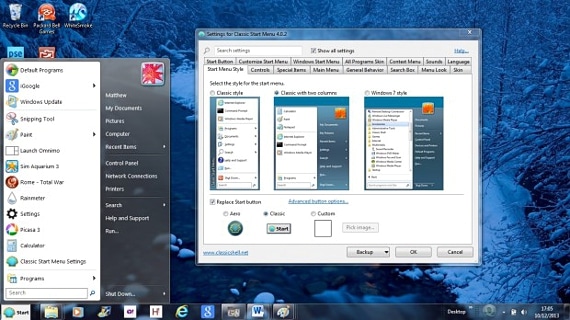

The menu was redesigned with Windows Vista to fit the Aero user experience. However, the feature was still in development after the cancelation of both Neptune and Activity Centers, with build 2250 including an incomplete version of it and build 2410 featuring a newer implementation that was rewritten using DirectUI. The page originated during the development of Neptune and Millennium, where it was implemented as an HTML application that would have fit in with the Activity Centers user experience.
CLASSIC START MENU WINDOWS 10 XP FULL
The Windows XP menu is based on an earlier design called the Start page, which is shown in full screen and features more columns, although it is still very similar in principle to the smaller panel introduced later. The menu also includes a link to account settings and power options. The right pane features quick links to user folders, recent documents, as well as network places and settings. Other programs could be accessed via the "All Programs" option in the bottom of the menu. The left pane includes links to the user's frequently used and pinned programs, as well as shortcuts to the machine's default internet and email program. The Start menu was redesigned with Windows XP to feature a two-column design, originally called the Start panel.

However, it can also be switched to small mode, which uses 16x16 icons and doesn't show any banner.Īlthough a new Start menu design was introduced in Windows XP, the classic Start menu was still retained as an option up to Windows Vista. By default, the main menu uses 32x32 icons and displays an operating system branding banner on the left side. It is also possible to add custom items on top of the menu by creating shortcuts in the Start Menu directory. The classic Start menu introduced with Windows 95 is a single column menu that contains power options, as well as shortcuts to help, settings, documents, and installed applications. The design further evolved in the following months, resulting in a single menu that combined the three menus and the Programs folder into a single interface, which was available by using the Start button on the taskbar.Ĭlassic Start menu Applications could be launched by browsing the "Programs" directory on the desktop, which was similar to the Windows 3.1 experience. An initial design tested in 1993 included a tray with the System, Find and Help buttons each exposing a part of the base operating system functionality in a menu. Microsoft aimed to fix this problem with a new desktop metaphor user interface originally planned for Cairo and later ported to Chicago. The program itself also suffered from its rather complex interface, with some common tasks such as exiting Windows being hidden in confusingly named menus. The peculiarities of Windows 3.1 window management meant that the program manager window would often get lost behind other windows, requiring the user to minimize multiple windows in order to launch an application. Prior to the introduction of the Start menu, Program Manager offered similar functionality using an MDI window.


 0 kommentar(er)
0 kommentar(er)
